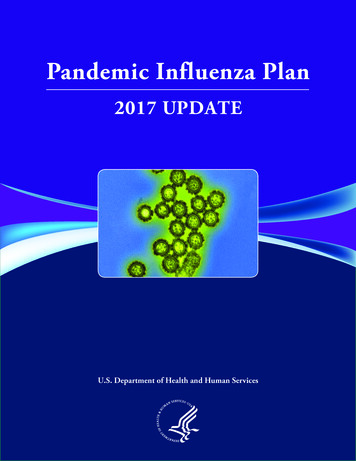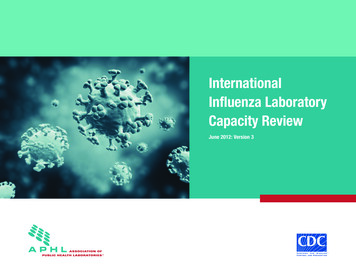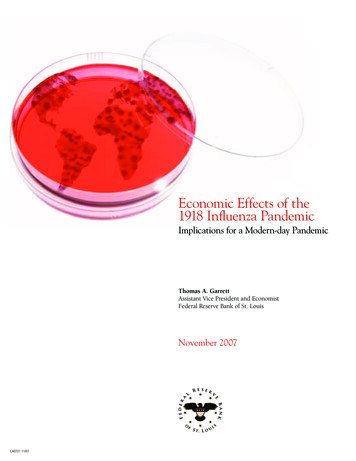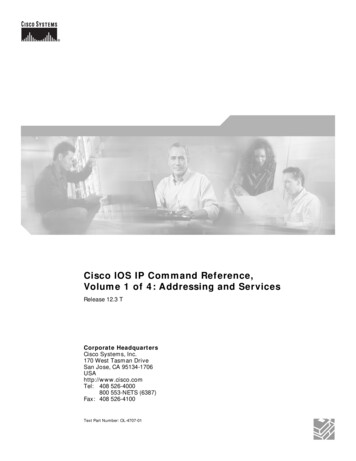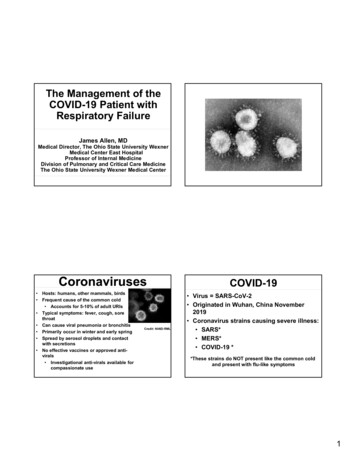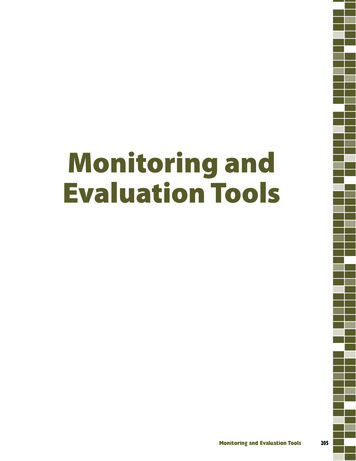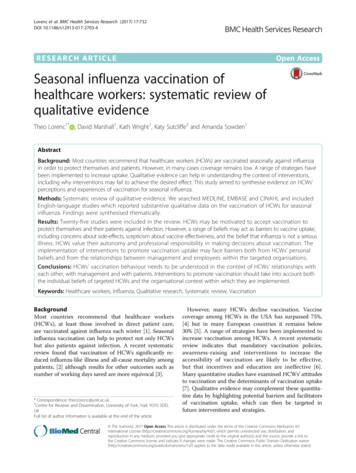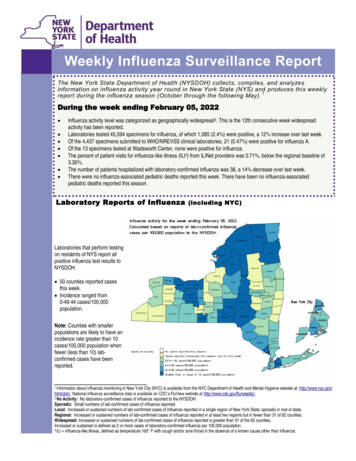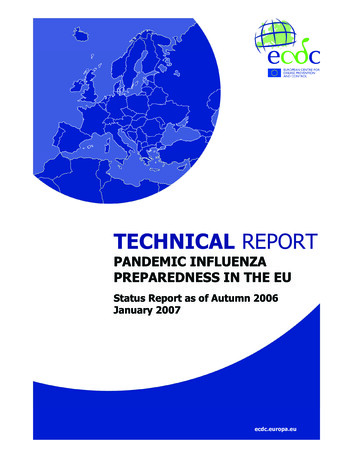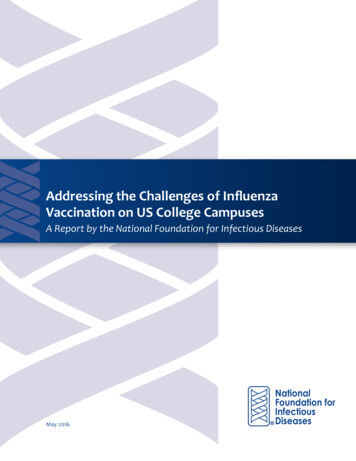
Transcription
Addressing the Challenges of InfluenzaVaccination on US College CampusesA Report by the National Foundation for Infectious DiseasesMay 2016January 2015
Addressing theChallenges ofInfluenza Vaccinationon US College CampusesOverview“According to the Centers for Disease Control andPrevention (CDC), annual vaccination is the best way toreduce the chances that an individual will get influenza(flu). Yet on US college campuses, flu vaccination ratesremain strikingly low, hovering between eight and39 percent,1, 2, 3, 4 and falling dramatically short of the 70percent Healthy People 2020 target recommendation5 aswell as the American College Health Association (ACHA)Healthy Campus 2020 target goal of approximately50 percent.6This discussion is so importantMotivating college students to get an annual fluvaccination remains a public health challenge; therefore,the National Foundation for Infectious Diseases (NFID)convened a College Influenza Stakeholder Summit thatincluded subject matter experts from academia, studentorganizations, professional medical associations, patientadvocacy organizations, and industry (see page 8 fora complete list of participating organizations) to betterunderstand the causes behind this vaccination gap.By bringing together these experts, the Summit soughtto better understand the key barriers that prevent collegestudents from getting an annual flu vaccine, as well asto identify strategies which would help students bothrecognize their risk and motivate them to get vaccinated.because we truly believe thatwe can do more together thanalone. By combining the uniqueexpertise of various stakeholders,we can build a future where collegestudents recognize the risk ofinfluenza, get vaccinated annually,and build life-long habits to protect”their health.— William Schaffner, MD,Medical Director,National Foundationfor Infectious Diseases2
Influenza Vaccination Rateson College Campuses Fall Shortof US Public Health GoalsEach Year in the USSeasonal flu is a serious, highly-contagious respiratoryillness caused by influenza viruses. In the US,approximately five to 20 percent of individuals get theflu each year, more than 200,000 are hospitalized, andtens of thousands die from flu-related complications.75 to 20%On college campuses, influenza viruses are knownto circulate rapidly, through constant exposure in closequarters like common living spaces, classrooms, sharedrestrooms, and through social activities. On average,college students who get the flu experience up toeight or more days of illness along with increased ratesof healthcare use, school absenteeism, and impairedacademic performance.8get the flu 1CDC recommends annual vaccination for all individualssix months and older as the best way to reducethe chance of contracting the flu.9 Despite theserecommendations, rates among college studentsremain low, hovering between 8 and 39 percent.1,2,3,4As the collection of baseline data in the collegiateenvironment is largely undocumented and/or selfreported, vaccination rates may indeed be lowerin this highly vulnerable population.200,000 are hospitalized 1Influenza vaccination programs on college and universitycampuses have been widely implemented, but withvarying levels of participation and success. Thus, theoutstanding question remains: Why is it so difficultto motivate college students to get vaccinated?Tens of thousandsdie from flu-related complications 1On average, college students whoget the flu experience illness ofeight days or more 21. Centers for Disease Control and Prevention. SeasonalInfluenza Q&A. www.cdc.gov/flu/about/qa/disease.htm.Accessed April 27, 20162. Nichol, KL, Tummers K, Hoyer-Leitzel A, et al. ModelingSeasonal Influenza Outbreak in a Closed College Campus:Impact of Pre-Season Vaccination, In-Season Vaccination andHolidays/Breaks. PLoS ONE, 5(3), e9548. http://doi.org/10.1371/journal.pone.00095483
Challenge: Students have varying levels ofawareness/attitudes toward the flu vaccine, sideeffects, and overall effectiveness. Flu educationand comprehension varies drastically based oncollege major, physical location (on-campus/offcampus resident), and college-targeted promotionalefforts before and during flu season. For example,student representatives at the Summit revealedthat there is substantial dialogue about the flu inschools of pharmacy, where students are requiredto get an annual flu vaccine. On the other hand,undergraduate students in non-health fields hadlittle to no awareness about flu prevention effortson their campuses. Importantly, stakeholders notedthat misconceptions about the side effects of theflu vaccine can perpetuate fear and create “shotaversion.” Various accounts were raised wherestudents reported reluctance to getting vaccinateddue to concerns that the vaccine would either causeillness or be ineffective at preventing flu.Challenges with College InfluenzaVaccination EffortsA key goal of the Summit was to secure a betterunderstanding of the underlying challenges and gapsrelated to flu prevention in this target audience. Whilethe challenges that stakeholders face in increasingawareness of flu and driving vaccination uptake arediverse, several themes did emerge, that if addressed,could help close the vaccination gap. Challenge: Healthy students don’t worry about gettingthe flu. College students are seemingly unconcernedabout the flu. There appears to be a conflicted beliefabout their own risk versus the risks to others —the “it won’t happen to me” mentality. Studentsacknowledged that flu prevention is often citedfor the very young or very old, but many in theirlate teens and early twenties believe that “they’llnever get sick.” Challenge: Busy schedules and competing prioritiesmake it difficult to capture student attention.Students are inundated with information rangingfrom academic requirements to on-campusevents, and have a number of extra-curricularcommitments. With busy schedules and competingpriorities, students can be de-sensitized to healthcommunication materials or awareness efforts thatseemingly have little relevance to their daily routine. Challenge: College students are transitioning tobeing responsible for managing their own health.Several stakeholders noted that many collegestudents are transitioning from an environmentwhere a parent or guardian coordinated all aspectsof their healthcare. Without a parental or othertrusted figure urging the student to get vaccinated,they likely won’t.4
Recommendations to Closethe College Vaccination Gap Challenge: College health services and on-campusflu prevention efforts vary from school to school.Flu prevention activities fluctuate across differentuniversities due, in large part, to a disparity in resources.Many larger universities have well-established fluvaccination programs with resulting stronger vaccinationuptake among students, while smaller schools withmore limited resources experience varying degreesof success. Large schools with robust on-campus healthservices, staff, and funding can remove barriers thatstudents may face in protecting themselves againstflu (e.g., no- or low-cost vaccines, vaccine clinics inmultiple locations around campus, incentives). Smalleruniversities, including community colleges, may notbe able to provide such a wide array of services orengage with student ambassadors with whom theycan collaborate. These schools often have one staffnurse who may only provide acute care and cannotprovide flu vaccines for no- or low cost.There is no one-size-fits-all solution to increasing fluvaccination uptake among college students: To beeffective, interventions must emerge from specific lessonslearned from college students themselves, rather than byextrapolating broad-brush approaches deemed effectivein other target populations. Yet, there are several elementsthat can be undertaken at a national level to help informregional and local implementation activities. Taking intoaccount the key challenges, best practices, and college liferealities shared during the Summit, the following emergedas key recommendations to help increase flu vaccinationamong college students: Recommendation: Conduct research to betterunderstand and quantify vaccination gaps, as wellas student motivators and influencers. Stakeholdersacknowledged the lack of reliable current researchthat accurately quantifies college student flu vaccinationrates and barriers to vaccination. Such research wouldassist public health officials, healthcare professionals,and individual colleges/universities in targeting theirefforts. Additionally, stakeholders acknowledgedthat health decisions among college students are“influenced” by a variety of factors and individuals.Athletes, healthcare professionals, professors, peers,and parents (primarily mothers) were all cited in havinginfluence over student behaviors; however, littleresearch exists to quantify the most direct leveragepoints. Better quantification of key motivators andinfluencers of this target audience — both on anational and local level — could assist in allowingofficials to more accurately tailor messaging, content,and programming to encourage behavior change.Additionally, research on the impact of flu onabsenteeism has helped motivate employers to sponsorflu vaccine programs. Similar research documentingthe disruption of the learning experience may helpmotivate colleges to be more active in promotingthe flu vaccine. Challenge: Uncertainty about, or limited insurancecoverage, bars students from receiving preventivecare. Students who are covered by insurance plansthat do not offer preventive services outside oftheir network or in other states often face difficultyaccessing flu vaccines. Others find the processes forreviewing benefits or submitting for reimbursementcumbersome. Because college health service stafftypically have limited means of guiding studentsto navigate their individual insurance plans, lowervaccination rates may ensue. Challenge: The definition of “college student” isquite broad, encompassing those who span multipleages, fields of study, and lifestyles, which may lead tovarying health behaviors. College students today donot conform to traditional age parameters. Althoughmany fall within the 18–24–year–old age range, othersare older. Depending on the school environment,students also have various living situations, with someresiding in on-campus dormitories and others commutingfrom off-campus. This diversity raises challenges whendesigning tactics to reach target audiences. Recommendation: Build solidarity among college,professional, and student organizations to highlightthe importance of flu prevention. Elevating thedialogue about flu involves collaboration betweencollege leadership, healthcare professionals, andstudents. Atypical partnerships and programco-creation that prioritize and incentivize the issueof flu prevention for all collaborators can assistin expanding the reach of important health messagesto students, activating a diverse set of ambassadorswho can champion the issue and make annualvaccination a basic tenet of healthy living.5
Recommendation: Facilitate best practice sharingand encourage uptake of existing flu education/vaccination resources. Moving into future flu seasons,stakeholders noted that streamlining resources iscritical. Significant tools and resources for raisingawareness about the importance of flu preventionand driving vaccination, many duplicative, alreadyexist through national organizations such as theAmerican Pharmacists Association, CDC, and NFID.In order to optimize efficiency, there must becontinued sharing of best practices, especially turnkeytemplates, actionable program ideas, and improveddissemination of resources through establisheddistribution channels and networks. Recommendation: Instill annual flu vaccination habitbefore the transition to college. Stakeholders notedthat there is currently a missed opportunity to morepurposefully communicate key messages about fluprevention as part of college readiness informationand healthcare exams. These opportunities providedirect peer/parent engagement and allow a healthcareprofessional, or other trusted advisor, to:1) Discuss the importance of vaccination, to helpprotect individuals and the community2) Debunk myths about the flu vaccine3) Enforce messages about the importanceof a healthy lifestyle while at college Recommendation: Make flu vaccination accessiblefor college health services and students. Schoolsthat experience the most success with flu vaccinationare those able to offer the vaccine to students freeof charge. However, this is not standard operatingprocedure. Many colleges and universities can onlyoffer limited support for both vaccine coverage andin helping students navigate individual insurancecoverage plans to recoup out-of-pocket expenses.Removing barriers related to supplying healthservices with adequate quantities of flu vaccine, aswell as fostering health literacy to empower studentsto better leverage existing insurance coverage for fluvaccines remain significant unmet needs.6
Key Tenets of Successful Influenza Prevention InitiativesMany college and university campuses currently have, and will continue to implement their own flu vaccination clinicsand programs. As such, the following were noted as tried and true principles to consider in the design of on-campusvaccination programs:Collaborate with the student bodyPromotional efforts should be informed by students.Involving students in the development and disseminationof campaign communications helps ensure relevance andresonance. A network of student advisors is critical to helpinform both message and channel (e.g., email vs. Snapchat).Also, and in an effort to incentivize participation, look forways to have student involvement either count towardacademic/community credit or resume building.The University of Wisconsin-Madison student healthservices boasts robust communications to drive studentsto get vaccinated at flu clinics as well as to educatestudents about the risk of flu. A student-inclusiveworkgroup is charged with helping to conceptualizethemes (e.g., “Boost Your Immunity”), assist in thedesign of creative materials, and advise on how best todisseminate those messages and materials on campus.Communicate early and often with a simple call to action(e.g., #GetVaccinated to #FightFlu)Sustained, frequent, and convenient communicationsto students prove to be the most impactful. Remindersare one of the most effective tools to making sure studentsreceive vaccinations. Regardless of the most appropriatechannel for the target student body (e.g., email or textmessage), early information about where to get fluvaccinations, clear directions, and regular reminderswill help students keep vaccinations top-of-mind whilethey juggle their often over-loaded schedules.Haverford College Student Health Services utilizedan e-health technology text message platform thatregularly reminded students to get their flu vaccineand communicated information about flu over an eightweek period. Text messages were linked to an onlineportal called “Prevent Haverflu” that contained personalstories and facts about flu. The regular, consistentcommunications and resources proved to be extremelyeffective in driving vaccination coverage to 50 percentof the student population.10Utilize influencersIdentifying influencers with resonance and leveraging theirimpact on student behaviors are keys to driving action.Star athletes, highly respected professors, healthcareprofessionals, parents/caregivers, and peers can all havedirect influence on student health behaviors. Activatingthese influencers to champion the call-to-action shouldbe considered when organizing flu prevention initiatives.At Temple University, the Industry PharmacistsOrganization, Eta Sigma Gamma, and the StudentHealth Services hosted a flu vaccine clinic with gueststar Nerlens Noel of the Philadelphia 76ers. The NBAplayer proved a popular spokesperson advocatingfor vaccinations at the Pennsylvania-based school.7
Be originalIncorporate a “WOW” factor to capture students’attention. What intrigues students may vary fromcampus to campus, but simple incentives and/ora competitive spirit can go a long way towardachieving results. Consider elements such as:By channeling students’ competitive drive, theUniversity of Minnesota and Vanderbilt Universityhave successfully organized annual mass vaccinationevents. In 2008, the University of Minnesota chargedthe student body with helping them break the GuinnessWorld Record for the highest number of vaccinationsin one day, generating an impressive 11,538 flu vaccinesdelivered. Vanderbilt University organizes mass fluevents called “Flulapalooza” that aims to top previousrecords for getting the most number of peoplevaccinated in an eight-hour period. In Michigan, the statedepartment of health teamed up with local collegesand universities to challenge students to get vaccinatedby encouraging friendly school rivalries and awardingprizes and recognition to the winning schools. Competition among student groups within or outsideof universities (e.g., school rivalries, nurses vs. doctorsvs. pharmacists) to get highest number of flu shots formeaningful prizes (e.g., grants, VIP tickets, etc.) Food GiveawaysAppeal to the desire to “give back”Include components that allow students to “give back” to society to appeal to millennial and Generation Z sensibilities.By emphasizing that flu vaccine helps prevent the spread of flu to others, campaigns can leverage the sense of communityand altruism, as well as motivate students to get vaccinated.Make it easy to get vaccinatedOffer flu vaccines at multiple convenient locations across campus and in short, concentrated time periods. Providingvaccination clinics in convenient locations across campus where students visit frequently (e.g., dormitories, studentcenters, libraries) helps eliminate barriers like distance, weather, or limited transportation options that prevent studentsfrom getting vaccinated. Additionally, galvanizing momentum to push for everyone to get vaccinated in a dedicated weekor two will avoid students from delaying action and the “I’ll do it later” mentality.SummaryWhile often preventable, flu can pose significant risks for vulnerable populations causing disruptions at workor school and in some cases, fatal complications.College students, living in high-touch areas and juggling overloaded schedules, are largely unaware of theirvulnerability to the illness. They often overlook the importance of, or face barriers to, taking preventivemeasures such as an annual flu vaccination.A uniform solution to motivate students and drive flu vaccination does not exist. However, with the collective effortsof academic, health, advocacy, industry, and student leaders to better understand and address the unique challengescollege students face, immunization goals can be met.While gaps certainly remain, past programs, existing resources, innovative partnerships, and improved researchcan offer best practices to more effectively meet the health needs of students on individual campuses.Students who get vaccinated against flu while in college are more likely to continue getting vaccinated after theyleave college. By continuing to raise awareness about flu and eliminating barriers to accessing vaccines, stakeholderscan empower college students to build healthy habits for a lifetime.8
Participating OrganizationsReferencesRepresentatives from the following organizationsparticipated in the 2016 College Influenza StakeholderSummit, which served as the basis for this report.1. Michigan Care Improvement Registry. TimelyImmunization Practice Strategies. March 11, 2016.Available at: pdf. Accessed May 2, 2016. American College Health Association2. Poehling KA, Blocker J, Ip EH, et al. 2009-2010 SeasonalInfluenza Vaccination Coverage Among College StudentsFrom 8 Universities in North Carolina. Journal ofAmerican College Health, 2012; 60 (8): 541 DOI:10.1080/07448481.2012.700973 American Immunization Registry Association American Pharmacists Association Association of Immunization Managers Auburn University, Student NationalPharmaceutical Association3. Yang Z J. Too Scared or Too Capable? Why Do CollegeStudents Stay Away from the H1N1 Vaccine?. 2012Oct;32(10):1703-16. DOI: 10.1111/j.1539-6924.2012.01799.x Families Fighting Flu Haverford College, Student Health Services4. Nichol KL, D’Heilly S, Ehlinger, EP. Influenza VaccinationAmong College and University Students Impact onInfluenza like Illness, Health Care Use, and ImpairedSchool Performance. Arch Pediatr Adolesc Med.2008;162(12):1113-1118. DOI:10.1001/archpedi.162.12.1113. National Foundation for Infectious Diseases Society for Adolescent Health and Medicine Temple University, Student Health Services Temple University, Industry Pharmacists Organization5. US Department of Health and Human Services. HealthyPeople 2020. Immunization and Infectious ectives.Accessed April 26, 2016. Texas A&M University, Minority Associationof Pre-Health and Pre-Medical Students University of Florida, Health and Education throughResearch, Outreach, Empowerment and Service University of Michigan6. American College Health Association Healthy Campus2020: Student Objectives. www.acha.org/HealthyCampus/HealthyCampus/Student Objectives.aspx. Accessed April27, 2016.This activity is supported by an unrestricted educationalgrant from Seqirus. NFID policies restrict funders fromcontrolling program content.7. Centers for Disease Control and Prevention. SeasonalInfluenza Q&A. www.cdc.gov/flu/about/qa/disease.htm.Accessed April 27, 2016.8. Nichol, KL, Tummers K, Hoyer-Leitzel A, et al. ModelingSeasonal Influenza Outbreak in a Closed College Campus:Impact of Pre-Season Vaccination, In-Season Vaccinationand Holidays/Breaks. PLoS ONE, 5(3), e9548. http://doi.org/10.1371/journal.pone.00095489. Centers for Disease Control and Prevention.Prevention and Control of Influenza with Vaccines:Recommendations of the Advisory Committee onImmunization Practices, United States, 2015–16 InfluenzaSeason. MMW Morb Wkly Rep. 2015;64(30); 818-825.10. Sharbaugh, Catherine DNP, MN, CRNP. Influenceof e-Health Technology Text Messages Linked to HealthPortal on College Students’ Influenza Vaccine Rate.Presented at the 2016 College Influenza Summit,Bethesda, MD.9
Copyright 2016 National Foundation for Infectious Diseases.www.nfid.org
Seasonal flu is a serious, highly-contagious respiratory illness caused by influenza viruses. In the US, approximately five to 20 percent of individuals get the flu each year, more than 200,000 are hospitalized, and tens of thousands die from flu-related complications.7 On college campuses, influenza viruses are known

